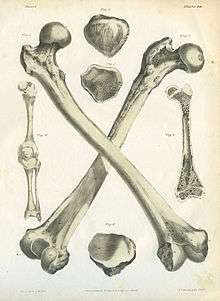Jones Quain
Jones Quain (pronounced "kwan") (November, 1796 – 31 Jan 1865) was an Irish anatomist, born at Mallow. Quain was professor of Anatomy and Physiology in the University of London. He was author of Elements of Anatomy, of which the first edition was published in 1828.
Biography
Quain, born in November 1796, was eldest son of Richard Quain of Ratheahy, co. Cork, by his first wife, a Miss Jones. His grandfather was David Quain of Carrigoon, co. Cork. He received the name of Jones from his mother's family. Richard Quain (1800–1887) was his full brother, and Sir John Richard Quain his half-brother. Sir Richard Quain was his first cousin. He began his education in Adair's school at Fermoy. He then entered Trinity College, Dublin, where, in 1814, he obtained a scholarship, then the highest classical distinction. He graduated in arts, and in 1820 he took the degree of bachelor of medicine, though he did not proceed M.D. until 1833. At the close of his college career he visited the continental schools and spent some time in Paris, translating and editing Martinet's Manual of Pathology.

Quain came to London in 1825 and joined, as one of its anatomical teachers, the Aldersgate Street school of medicine founded by Frederick Tyrrell. The other teacher of anatomy was William Lawrence. While engaged there he published Elements of Anatomy which became a standard text-book in English-speaking countries. An attack of hæmoptysis occurring while he suffered from a dissection wound compelled him to take a rest for two years.
Quain accepted in 1831 the office of professor of general anatomy at University College, then vacant by the resignation of Granville Sharp Pattison; Richard Quain, his brother, acted as senior demonstrator and lecturer on descriptive anatomy, while Erasmus Wilson was his prosecutor. He was also invited to lecture upon physiology. He resigned his post at University College in 1835, and in the same year he was appointed a member of the senate of the university of London. He lived in retirement during the last twenty years of his life, and chiefly in Paris, devoting himself to literary and scientific pursuits. He died, unmarried, on 31 Jan. 1865, and was buried in Highgate cemetery. Quain was an elegant and accomplished scholar, and he was deeply interested in literature as well as science.[1]
Works
His medical writings were:
- Elements of Descriptive and Practical Anatomy for the use of Students, London, 1828; 2nd edit. London, 1832; 3rd edit. 1834; 4th edit. 1837; 5th edit. edited by R. Quain and W. Sharpey, 2 vols. 1848; 6th edit. edited by W. Sharpey and G. V. Ellis, 3 vols. 1856; 7th edit. edited by W. Sharpey, Allen Thomson, and John Cleland, 2 vols. 1864–7; translated into German, Erlangen, 1870–2; 8th edit. edited by W. Sharpey, Allen Thomson, and E. A. Schäfer, 2 vols. 1876; 9th edit. edited by Allen Thomson, E. A. Schäfer, and G. D. Thane, 2 vols. 1882; 10th edit. by E. A. Schäfer, and G. D. Thane, 3 vols. 1890, &c.
- Martinet's Manual of Pathology translated, with notes and additions, by Jones Quain, London, 1826; 2nd edit. 1827; 3rd edit. 1829; 4th edit. 1835.
- With Erasmus Wilson, A Series of Anatomical Plates in Lithography with References and Physiological Comments illustrating the Structure of the different Parts of the Human Body, 2 vols., London, 1836–42.[1]
References
- 1 2
 Power, D'Arcy (1896). "Quain, Jones". In Lee, Sidney. Dictionary of National Biography. 47. London: Smith, Elder & Co.
Power, D'Arcy (1896). "Quain, Jones". In Lee, Sidney. Dictionary of National Biography. 47. London: Smith, Elder & Co.
- Attribution
 This article incorporates text from a publication now in the public domain: Lee, Sidney, ed. (1896). "Quain, Jones". Dictionary of National Biography. 47. London: Smith, Elder & Co.
This article incorporates text from a publication now in the public domain: Lee, Sidney, ed. (1896). "Quain, Jones". Dictionary of National Biography. 47. London: Smith, Elder & Co.  This article incorporates text from a publication now in the public domain: Wood, James, ed. (1907). "Quain, Jones". The Nuttall Encyclopædia. London and New York: Frederick Warne.
This article incorporates text from a publication now in the public domain: Wood, James, ed. (1907). "Quain, Jones". The Nuttall Encyclopædia. London and New York: Frederick Warne.